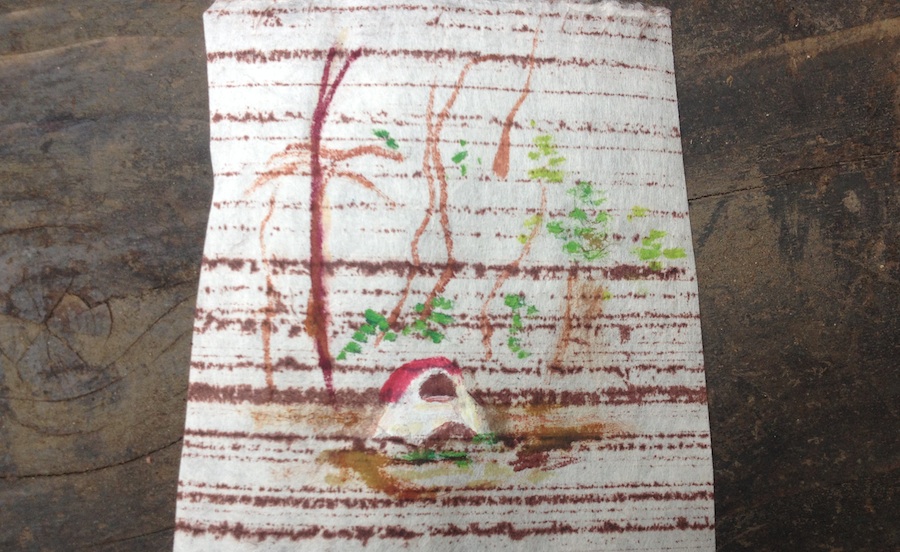
Not so far away, coyotes were howling and a frighteningly large cicada swirled around our lantern. The animals of Joshua Tree, California, were converging on us with fluttering wings and in small packs, both physically and through the airwaves. I had just finished Madeleine L’Engle’s novel, A Wrinkle in Time. I thought about Mrs. Whatsit wisely advising her company to allow the protagonist, Meg, to brave the unknown, unprotected: “You are going to allow [her] the privilege of accepting this danger.”
Joshua Tree by night was fraught with something akin to that dangerous, but maybe momentous, unknown. Our tent was oddly filled with light (from the fire, the stars overhead, an alien power?). We were still camping novices at that point. (Actually, who am I kidding? I am still a camping novice.) We had to set up our tent after nightfall, and the darkness, especially shadowed by the strange rock formations all around us, and the sounds and movement of fauna, was altogether spooky.

By daylight, Joshua Tree’s bulbous rock formations, formed by magma, begged to be climbed. They looked like something that oozed out of the flat earth surface, like rough, melted and hardened blobs of sugar. Late one night, we saw two fellows make their way up one of these rocks – a formation that had a rounded enclave some twenty feet up – just to hang out in the darkness. They had red headlamps and, as they ascended, they looked like huge lightning bugs bobbing up the rock, then getting caught in a nook.

Our first night camping, we stopped in Big Sur, California. Many of the trails were closed because of a recent forest fire. Mother Nature needs time to heal and cannot always accommodate visiting hikers and explorers. The first evening we spent there, we had the pleasure of partaking in a local Trivia Night. A fellow trivia enthusiast, a man from Eastern Europe, competed as “Solo Team.” He did quite well.

In Arizona, I finally felt the triumph of camping: it had been four days. No grocery shopping, no electric light switches or running water. Arizona’s landscape was strange but beautiful. The most delicate wildflowers sprinkled the edges of the highway in colors that felt too bright. Orange! Purple!
After years of seeing it depicted in animated films and in graphic design patterns, the saguaro cactus looked absurd in real life. I kept thinking about the symmetrical saguaro, Joe Cactus, featured in Peanuts; Snoopy’s brother, Spike, is something of a desert-based philosopher who often confides in this plant. Spike offers these tender moments of almost delusional reflection, like a content but confused ascetic. “Living in the desert isn’t all bad. There’s beautiful scenery. And good conversation. Hi rock,” Spike once said. I felt similarly reflective amongst the organ pipe, enormous saguaro cactus, and cholla plants. Everything around us was potentially harmful, spiky. It makes a person mindful and attentive to one’s environs.  I wrote in my journal: “We have a lantern and ate macaroni for dinner. Tea for dessert. And crosswords.” I found I enjoyed preparing for the day’s adventures, the satisfying work of rationing out our food and entertainment. We were getting accustomed to a new, earlier sleep pattern: once the last ember sizzled from our campfire, we retired for the evening. The clock read 10:30 or so.
I wrote in my journal: “We have a lantern and ate macaroni for dinner. Tea for dessert. And crosswords.” I found I enjoyed preparing for the day’s adventures, the satisfying work of rationing out our food and entertainment. We were getting accustomed to a new, earlier sleep pattern: once the last ember sizzled from our campfire, we retired for the evening. The clock read 10:30 or so.
I am reminded now of a book my mother loved, Ram Dass’s Be Here Now (1971), which urges the reader to find peace in the present. I keep seeing this book, outside the context of our home library, and I find it timely still. It feels especially relevant when you are camping in a Martian-like landscape under the stars.
Camping is cool, man. And, outside, does feel like a privilege to accept the danger of what might be, what is, and to ultimately be here now.

California native Chloe Nelson is an art historian and musician moonlighting as a curator of Americana. She’ll be sending in photo-essays from time to time for a Road Songs series on the mnartists blog as she drives across the country, harmonizing and honky-tonking in country outfit Tanbark. She tweets @chloefnelson. All photos taken by the author.
Get Walker Reader in your inbox. Sign up to receive first word about our original videos, commissioned essays, curatorial perspectives, and artist interviews.